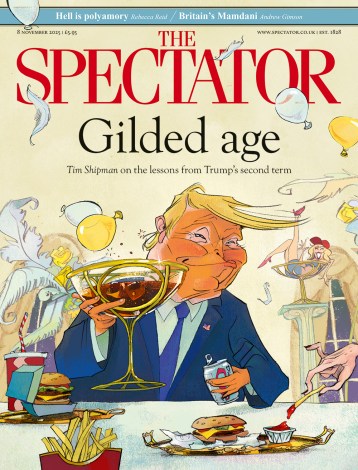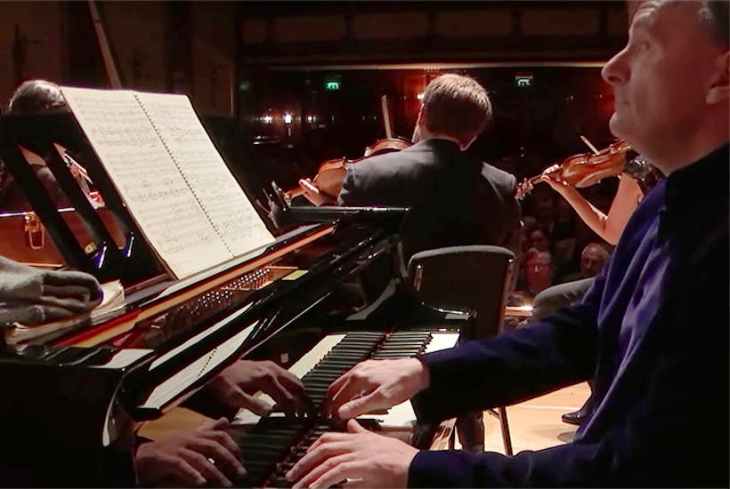Looney Tunes was always at its best when soundtracked by a Hungarian gypsy dance. (Watch ‘Pigs in a Polka’ if you don’t believe me.) It’s music that was made to chase small cartoon animals — and terrify conductors. The gunshot syncopations. The hand-break turns in tempi. The banana-skin portamenti and rubato ravines… Musical tripwires everywhere.
Nothing to faze conductor Ivan Fischer, however. Last week at the Proms, with the Budapest Festival Orchestra, Fischer was giving a guided tour of Hungarian gypsy music and its century-long cohabitation with classical music. It was a masterclass. Without breaking a sweat, he suavely explained the provenance of each piece to the audience, then swung round into the line of fire, Bugs Bunny-ing his way through the musical grapeshot, all while balancing the hair-raising needs of two gypsy violinists and a cimbalom player. As he bowed, I half expected him to whip out a carrot and cross his legs with a ‘What’s up, Doc?’
Gypsy culture was to 19th-century classical music what rhythm and blues became to 20th-century pop. Part cultural exchange, part stolen goods. Not that the gypsies did too bad out of it — they often pinched back the rearranged tunes and fed it to their customers as echt gypsy. At this Prom, Fischer was trying to give the gypsies their dues. Centre stage: three extraordinary gypsy performers, who were invited to cut right across the canonical dances and rhapsodies by Liszt, Brahms and Sarasate with pleasing disregard for taste or propriety.
The violins of Jozsefs Lendvai and Lendvay (father and son) crunched and creaked and popped and squeaked, musky, brandy-soaked, encrusted in harmonics, on the edge of intelligibility. It would take classical music another 100 years to get its head around the possibilities of playing like this, and come up with a pompous name for it: ‘extended technique’. The gypsies had it in their fingers and bows all along. Helmut Lachenmann, eat your heart out.
Did it always work musically? Maybe not. But, boy, was it fun. And at the interval it made our bottom lips quiver, as Jozsefs senior and junior took on the raw sighs and sobs of Brahms’s Hungarian Dance No. 11. By the end of the concert, we were in raptures, the Royal Albert Hall corridors filled with humming, as they lodged one last dance, Brahms’s Hungarian Dance No. 4, in our ears and throats.
Anyone who’s seen the BFO will know the rabbit they pulled out of a hat in the encore. They began to sing, as a choir, harmonising while they played. I don’t know how many times I’ve seen them do this, but it always floors me. The sense of an orchestra actually enjoying themselves, wanting to communicate this joy as directly as possible, the generosity and talent and spirit of it all is quite overwhelming. In the encore the night before, they accompanied the soprano from Mahler 4 in a pitch-perfect performance of Mozart’s ‘Laudate Dominum’. A night with the BFO is terribly corrupting. It has the effect of making you realise how lousy and routine and oafish most other orchestral concerts are.
The meat of their visit, renditions of Mahler 4 and Brahms 1, made this point even clearer. Where most conductors would have hit the throttle to impress, Fischer, with this instrument, could revel in specifics, letting his principals dig deep and root around.
His Mahler 4, lovingly slow and vivid, was able to treat us to some freshwater flutes and stony harps and clarinets that waddled and quacked. Speeds were strict, then suddenly all melty and delicious, like a dad relenting to a kid, magicking up a cream bun from behind his back. There was a second cream bun to come: the lip-smacking soprano of Anna Lucia Richter, so perfectly fresh, sweet and home-made.
In the first half there were two more extraordinary exercises in folk music manipulation. Enescu’s Suite No 1 — Prélude a l’unisson was more meteorological than musical, a crisp blast of windy easterly weirdness for strings and timps. Bartok’s Music for Strings, Percussion and Celesta, meanwhile, feels like you’re watching a combine harvester munch through a folk band.
The BFO’s performance was instinctive rather than crafted. As was the soupy start of Brahms 1 the next night. Where was Fischer going with this? I shouldn’t have doubted him. That blind worminess in the first movement, the orchestra as a coagulated mass, became the perfect incubator for what was to come, a rich swamp from which life could teem, an ideal foil to the calibrated shades and groves of the middle movements and the explosive finale, and all the characterisation therein, the sackbutty trombones, kingly strings and brassy flutes. Oh, that concerts could all be like this.






Comments